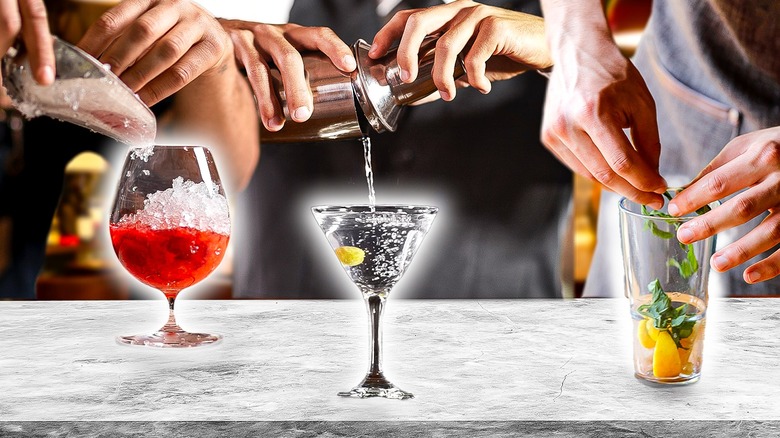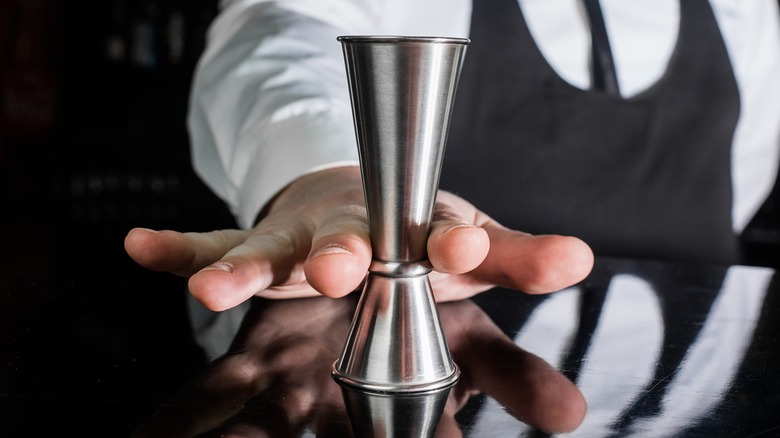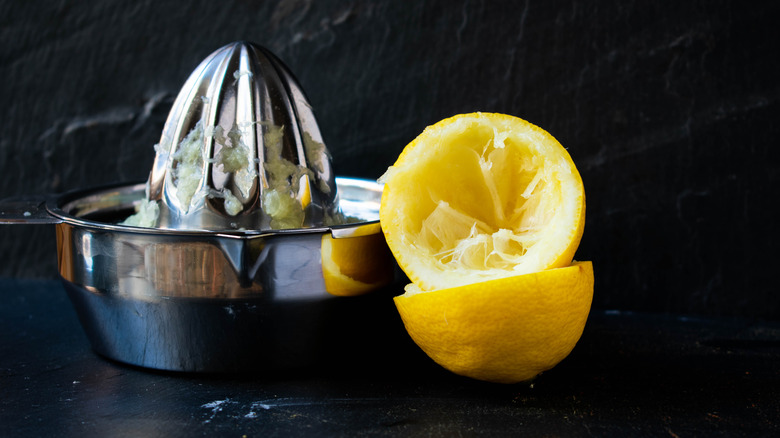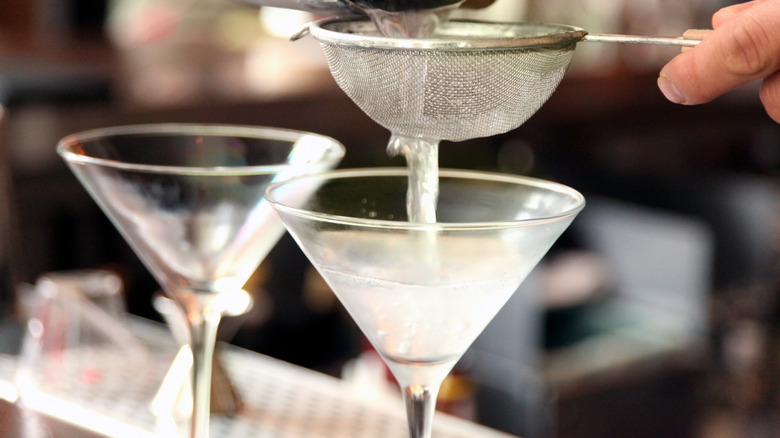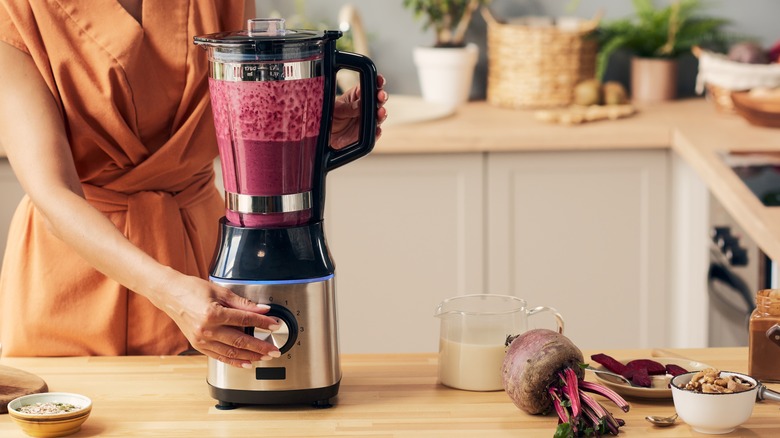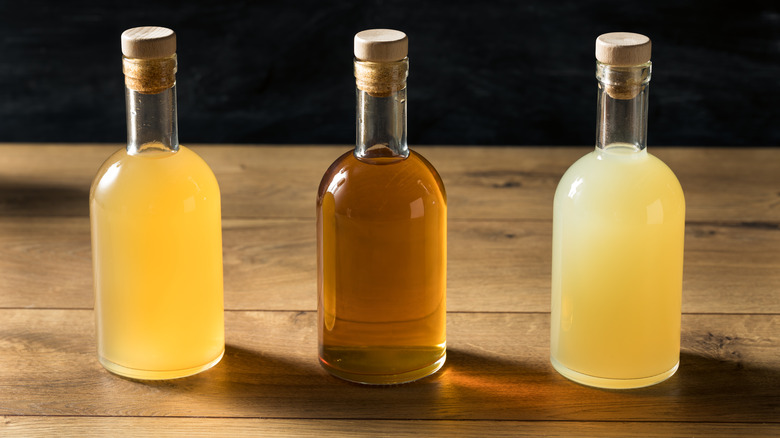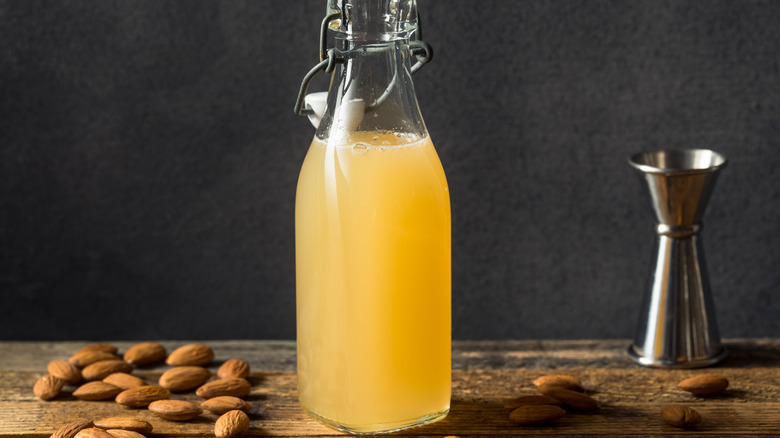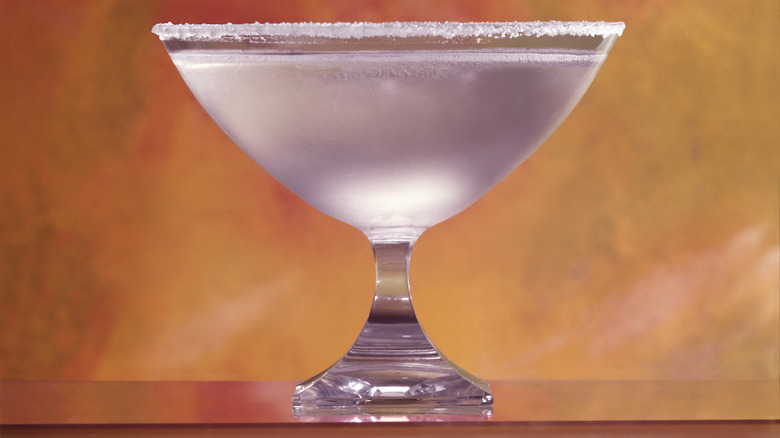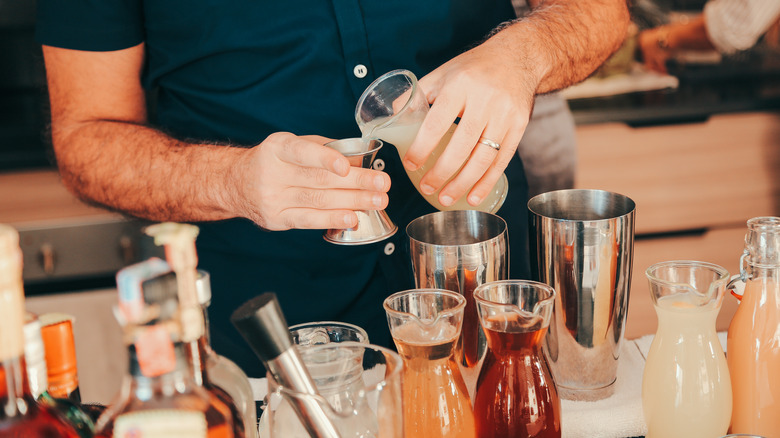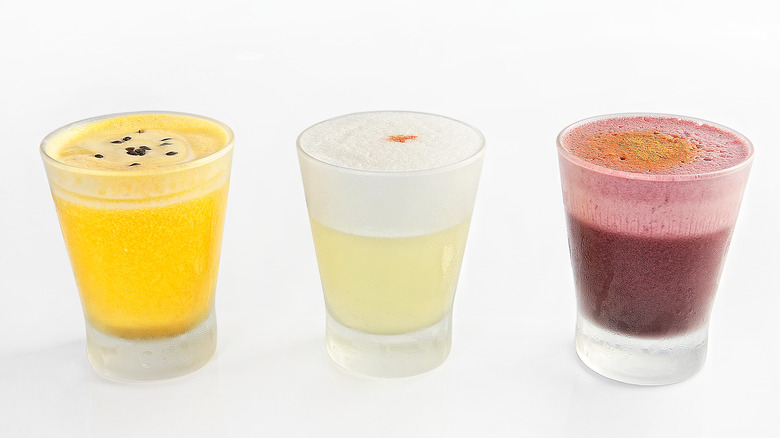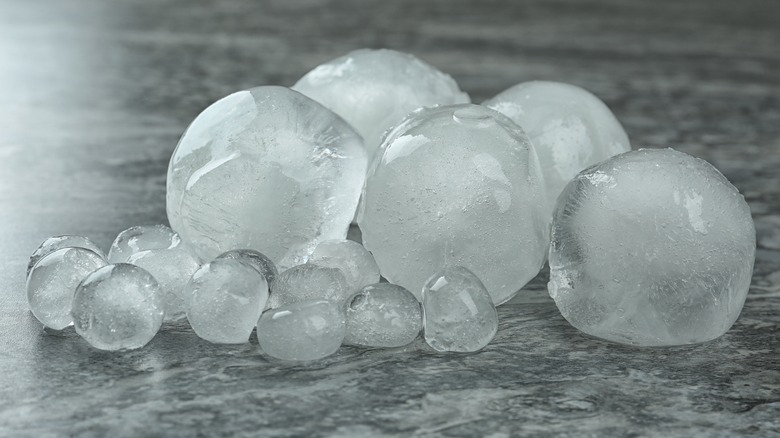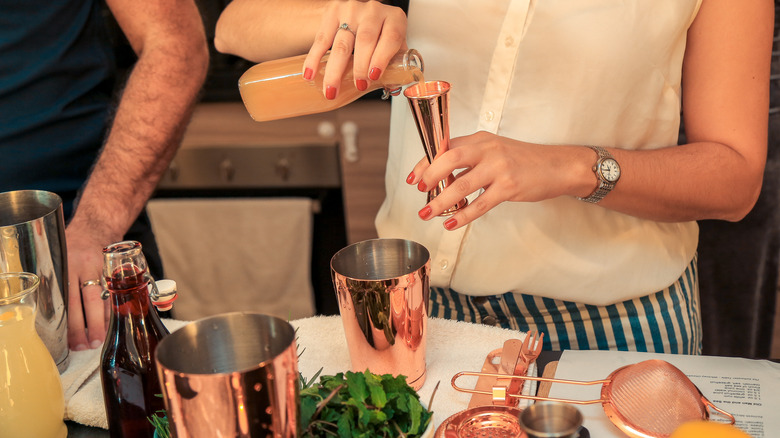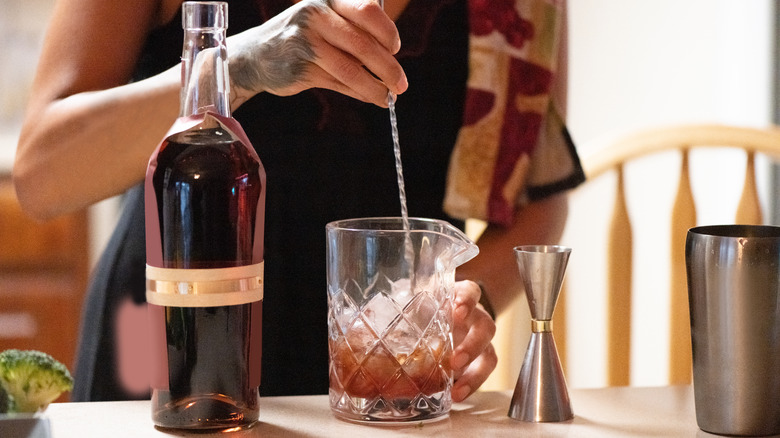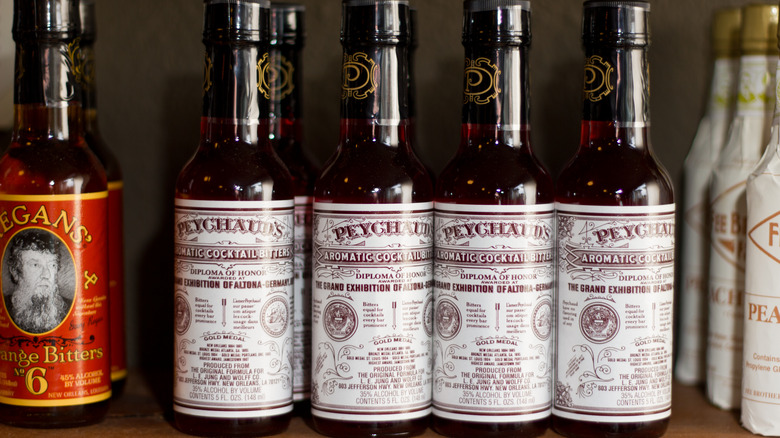13 Cocktail-Making Hacks That Are Sure To Make Life Easier
Whether you're throwing a cocktail party for your friends, or unwinding alone with an ice-cold martini, there are some tips you can learn that will make your drinks better. With a bit of knowledge and planning, every home bartender can make cocktails as delicious and consistent as a practiced mixologist. If you are looking to master the art of drink crafting, this guide is here to help.
Before you start, ensure that you have a set of good equipment. A mixing glass, a jigger for measuring, a set of shakers, one or two spoons, and a strainer are the basic tools you'll need to make almost any drink. Stock up on ice and your favorite spirits, liqueurs, and mixers and you're ready to get shaking (or stirring, depending on the cocktail). Read on to discover 13 cocktail-making hacks that are sure to make life easier. You will be happy you did.
1. Use a jigger and measure, measure, measure
When you're first learning to make cocktails, measuring ingredients is crucial to your success. Even with years of experience, master mixologists still stop to measure. Balance is a critical component in cocktails; an out-of-balance drink can be overwhelmingly sweet, bitter, sour, thin, or just generally unpleasant. Measuring is the best way to achieve balance, craft consistent drinks, ensure your ratios are correct, and gauge how much alcohol you're serving or consuming.
Learning to free pour — which is being able to pour precise amounts without using a measuring tool — is a skill that some bartenders are able to learn. However, it takes a lot of practice, and they still need to measure occasionally to check their pouring accuracy. It's always best to measure, and the tool that most bartenders use to do so is called a jigger.
Jiggers come in many different styles and sizes. Some look like small liquid measuring cups and are transparent with markers along the side. Others are cone-shaped and made of metal and have markers on the interior. Which one you use depends on personal preference, as they all achieve the same goal: making consistent and balanced drinks.
2. Get a good citrus juicer
To make your cocktails taste as vibrant and fresh as they do at your favorite fancy bar, start with citrus. Classic cocktails like the gimlet, margarita, or cosmopolitan all need citrus. The lemon or lime juice component of these cocktails needs to be as fresh as possible in order to round out the flavors. If you're using subpar lemon or lime juice that's been sitting around — or store-bought stuff that's been hanging out on a grocery store shelf for ages — you won't get the same effect as you will with a fresh-squeezed jolt of juice. A good citrus juicer doesn't have to be fancy or expensive, but having a reliable one makes it easy and quick to juice on a whim.
Manual juicers work fine, especially if you're making a smaller batch of cocktails. There are hand juicers that work like a press, and round juicers which sit on a countertop and collect the juice in a bowl underneath. Both styles are easy to use and clean.
If you plan on having lots of frequent cocktail parties, you may want to consider investing in an electric juicer that can handle more volume. Unfortunately, these devices also take a little more maintenance and space. Whichever style you choose, make sure you use the juice within a few days. After that, it loses its potency.
3. Chill your glassware
With a few notable exceptions like hot toddies or hot buttered rums, cocktails are meant to be served and consumed cold. No one likes a lukewarm martini or a room-temperature margarita. The best way to make sure your painstakingly crafted cocktails are enjoyed at their ideal coolness level is to pour them into a chilled glass.
By using this hack, the glass itself works to keep the liquid from warming up as it comes in contact with ambient temperatures. It's an extra level of protection that allows you to sip your cocktail slowly without fear of it becoming unpalatable.
This step is significant for drinks "served up" — an expression that refers to cocktails that are strained and served without ice. But even drinks served "on the rocks" — meaning those served with ice — can benefit from the extra chill provided by a frosty glass. This hack keeps the ice frozen a bit longer, which also helps to prevent the cocktail from getting diluted and watered down too quickly. You can chill glassware by leaving it in the freezer or refrigerator, or by filling it with ice and water for a few minutes, then dumping the ice water right as your cocktail is ready to be poured.
4. Use a blender for speedy infusions
One of the best methods to add flavor to cocktails is to make an infusion. Combine a base spirit and a flavoring agent (like a fruit, herb, or spice) and let then let the combination sit. Over time, the spirit will take on the flavor of the other ingredients, and you've got a fun new item to make cocktails with. The only drawback is that typically infusions take time, from days to weeks. Fortunately, there's a way to speed up the process. All you need is a blender.
Pureeing ingredients with a base spirit is like going into hyperspace — it speeds up the process, turning a weeks-long process into mere moments, adding flavor to the spirit practically instantly. Depending on the ingredients you're using, you may need a powerful high-speed blender. But if your blender can handle a basic smoothie, you should be able to infuse most ingredients. Once the items are pureed, strain the solids out using cheesecloth or a coffee filter. You'll be left with a uniquely flavored spirit to play with in your cocktail recipes.
5. Batch your favorite cocktails
Making cocktails in batches is a fantastic way to enjoy hand-crafted drinks on a whim. For parties, having drinks prepared in advance allows you more time to socialize and have fun, rather than being stuck churning out beverages for your guests. But even if you're not planning a get-together, having batched cocktails on hand is convenient. This hack allows you to enjoy a complex drink anytime, without putting in too much effort.
There are a few guidelines to keep in mind when batching cocktails. The first is measuring. Double and triple-check when you multiply the amounts for large batches, so you don't end up wasting expensive liquor. Second, unless you plan on serving the whole batch right away, don't add any fresh or perishable ingredients — you can mix those in later. Such ingredients include juices, egg whites, and fresh fruit. The same goes for bubbly ingredients like soda water or sparkling wine. These ingredients will lose their effervescence over time, and they should be added to each drink separately, as each one is served.
Spirit-only cocktails made with equal parts (like the Negroni) are the best candidates for batching. No measurements are required, and all you need to do is stir each with ice and serve. It gets a little more complicated with other types of drinks. But no matter what, batching a cocktail will save you time in the future.
6. Make your own syrups
If you're the kind of home bartender that likes to experiment and loves a kitchen project, homemade syrups may be just what you're looking for. Syrups are an easy and (sometimes) inexpensive way to add new flavors to your cocktails. Start by learning how to make simple syrup, which is just sugar and water. Once you've mastered that, there is no limit to the kinds of syrups you can create.
Baseline simple syrup is made with a one-to-one ratio, in which equal parts sugar and water are heated until combined. For a more decadent syrup, you can adjust the ratio to include more sugar. This will also add more texture to your drink. You can infuse simple syrups with any ingredients to give them flavor. Fresh herbs, fruit, dried tea leaves, and whole spices all work well. More complex syrups, like orgeat and gum syrup, take extra work but can be worth it to try making. Come up with your own flavor combinations and experiment — before you know it, you may have your own collection of signature cocktail recipes.
Keep in mind that syrups don't last forever. They should be stored in the refrigerator. After a few weeks, make sure you check for any mold or other signs of spoilage and throw anything out that seems off.
7. Season your drinks with a little salt
We use salt to bring out the flavors in food, so why isn't this considered common practice with drinks? There is no reason to limit yourself to drinks like the margarita or salty dog, which are both made with salted rims. Salt can be added in many different forms to just about any cocktail. In doing so, you'll add dimension and flavor to the beverage.
Adding salt decreases our perception of bitterness, which can help balance intense bitter flavors from ingredients like tonic water, grapefruit juice, or bitter-tasting liqueurs. Salt also boosts sweet and sour flavors, so, if you want your citrus ingredients to really pop, just add a dash of salt.
To make it even easier to add to your drinks, you can make a saline solution, so your salt is already in liquid form. Similar to a simple syrup, just heat a mixture of salt and water until combined. However, in this case, you don't want to go with a one-to-one ratio. Ten parts water to one part salt is a good place to start, and you can then adjust its intensity to your taste. A tiny dash of saline is all you need to jazz up the flavors of your cocktail.
8. Learn classic cocktail ratios
Conceiving and creating cocktails may seem daunting, but there's a secret to it. Most cocktails, even the most experimental and outlandish recipes, are derived from the classics. Newer cocktails use these older recipes as their blueprints, taking the initial drink's categories of ingredients and their ratios as inspiration.
Something to keep in mind is the golden ratio. This recipe breaks down like this: two parts spirit, one part sour, and one part sweet. You can use these proportions — along with ingredients such as gin, lime, and simple syrup — to create a gimlet. Replace the gin with rum and you have a Daiquiri. Tequila, lime, and orange liqueur give you a margarita. Whiskey, honey, and lemon give you a gold rush. Mix and match ingredients using this ratio and you can invent an endless number of drinks, making little adjustments and variations to suit your taste.
Use other classic drinks to do the same. A Manhattan is traditionally two parts spirit (in this case, whiskey) to one part vermouth, with a dash or two of bitters. Try using a different spirit, and replacing vermouth with another type of aperitif, and you have a whole new category to play with.
9. Do the reverse dry shake for foam drinks
Egg-white cocktails are some of the most challenging drinks to master, for home and professional bartenders alike. When made correctly, the egg white is shaken so intensely that, as it combines with the other ingredients, it becomes a foam that layers perfectly on top of the drink as it's poured into the glass. The pisco sour is one of the most well-known drinks in this category.
There are many different techniques bartenders have devised in order to create the perfect egg white foam. What's known as the "dry shake" was the go-to method for years. This entails first shaking the egg white with your cocktail ingredients (but without ice) to create the initial foamy texture, then adding ice and shaking it again to dilute and chill the drink. This works okay, but shaking without ice takes more physical effort. Additionally, the second shake with ice tends to water down the foam.
The "reverse dry shake" solves both of these problems. First, add all of your ingredients including egg white and ice to your shaker. Give it a long, intense shake, strain out the ice, then give it a second round of shaking. Doing the shakes in this order results in a perfectly chilled cocktail topped with gorgeously fluffy, silky foam.
10. Expand your ice selection
All ice is not created equal. The size and shape of ice greatly affect the creation and enjoyment of any cocktail. Ice dilutes and breaks down at different rates depending on its characteristics, so when you're shaking or stirring a drink, it's crucial to have a basic understanding of how fast your ice is turning to water. You don't want to end up with a drink that's too thin and watery, nor do you want to drink a lukewarm cocktail.
Silicone ice molds come in all shapes and sizes. Your best bet for successful cocktail-making is to have as many different styles of ice on hand as possible. We recommend you experiment with different kinds, especially when shaking or stirring. See what happens when you serve drinks over crushed ice, as opposed to large cubes. One large piece of ice will dilute much more slowly than several smaller ones, as there's less surface area in contact with the drink. Consider this when deciding what type of ice will work best for your cocktail.
11. Taste and adjust as you go
A big part of learning how to make cocktails is knowing when a drink is not quite right and figuring out how to fix it. You've probably seen bartenders dip one end of a straw into a drink and taste it — that's what's known as a straw test. Much like how a chef will taste their food for seasoning, a bartender will often taste a tiny bit of their cocktail to make sure it's made correctly. A veteran mixologist will be able to tell instantly if the drink needs adjusting, whether it's too sweet, too bitter, or too sour. Then it's a matter of knowing what to add in order to create the balance they're after.
As you make cocktails at home, be sure to taste them and really give some thought to what your palate is telling you. If the drink is overly sweet, add something acidic or bitter to counteract it. If it's too hot and boozy, it may need a longer stir or shake with ice. If it's too flat and boring, throw something spicy or savory in there and see what happens. The more you taste, the more you'll understand your own palate, and what makes a drink taste great.
12. Learn when to shake, stir, and build
The modern cocktail world is all about experimentation, but there is also a strong foundation of knowledge and technique that it's built on. There are a few rules that are important to know when making cocktails. While rules are made to be broken, it's crucial to at least understand them before you decide to forge your own path. Knowing when to stir, when to shake, and when to build a cocktail is one of the fundamentals that will put you on the right track.
On the surface, stirring and shaking serve the same purpose — both mix, dilute, and chill the cocktail. But the resulting drinks will have marked differences depending on which method you use. Shaking breaks down the ice more intensely and quickly, and the combination of motion and colliding ice aerates the drink, giving it a frothier texture and an often cloudy appearance. Stirring is more gentle, takes longer to achieve the same level of chill and dilution, and results in a silkier textured drink with a smoother mouthfeel and a clear appearance. The rules of thumb are to shake anything that involves cloudy ingredients — think citrus juices, dairy, or egg whites. If your drink is all spirits, it's best to stir.
Building a drink is the third option. This is when ingredients are added directly to the glass they're served in. Old fashioneds are often made this way, as well as carbonated drinks like the gin and tonic.
13. Invest in bitters
If you're not familiar with cocktail bitters, they're basically highly concentrated infusions. Most are made with a neutral spirit base (although some are made without alcohol), which is combined with various botanical ingredients to create an intensely aromatic and flavorful liquid. Just a dash or two of most bitters is enough to completely transform the flavor of any drink.
Two of the most common bitters brands are Angostura and Peychaud's. Angostura — which is made with the flavors of clove and other pungent spices — shows up in Manhattans and Old Fashioneds. Peychaud's bitters are brighter, with a distinct anise flavor. They are called for in the Sazerac cocktail. Orange bitters are another common category. They add a concentrated citrus note to drinks.
The world of bitters is vast. It has exploded with the modern craft cocktail movement — from habanero to tobacco to cucumber, you can find a bottle of bitters with just about any flavor you can imagine. Having a wide selection on hand allows you to add unique punches of flavor to all of your creations. Plus, since you only need a few dashes per drink, they tend to last almost indefinitely.
